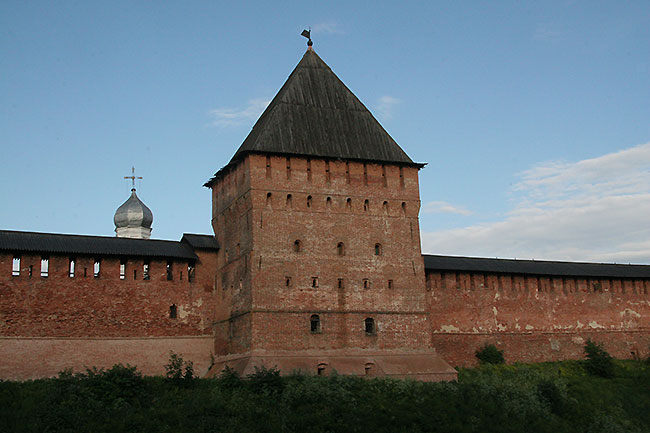The Intercession tower
 A short stretch of wall with swallow-tailed merlons that have recently been restored separates the Kukui Tower from the Intercession Tower which got its name from the gateway church built by the boyar Semion Klimovich and rebuilt in 1389 by the posadnik Gregory Yakunovich. This tower differs from the rest because of its numerous embrasures, loopholes, upper firing platforms and complex system of inner passages. A short stretch of wall with swallow-tailed merlons that have recently been restored separates the Kukui Tower from the Intercession Tower which got its name from the gateway church built by the boyar Semion Klimovich and rebuilt in 1389 by the posadnik Gregory Yakunovich. This tower differs from the rest because of its numerous embrasures, loopholes, upper firing platforms and complex system of inner passages.
It is also built at a different angle to the wall. Whereas all the other towers only protrude very slightly beyond the outside of the wall, the Intercession tower stands almost completely free of it. All these features indicate that it was built at a time when cannons were already being used and the main concern of the builders was to see that the walls of the citadel could be covered by cannon fire. This is also borne out by the increased thickness of its walls, three metres in the lower sections, and by the fact that there are embrasures and loopholes at all levels, particularly on the upper firing platforms. All this enables us to date the tower to a somewhat later period than the others, namely, the beginning of the 16th century. Its architecture is also similar to that of the towers built in Central Russian strongholds at the end of the 15th and the beginning of the 16th century.
References to the Intercession tower from the 14th century right up to the end of the 18th century mention that it contained a gateway. The chronicle entry for 1493 speaks of the Intercession Gate of the citadel. Since the present structure bears no traces of a gate it was obviously built on the site of an older tower of the same name.
|